
SOIL SCIENCE SOCIETY OF AMERICA JOURNAL
Scope & Guideline
Cultivating a Deeper Understanding of Soil Ecosystems
Introduction
Aims and Scopes
- Soil Health and Management:
Research focusing on practices that enhance soil health, including conservation tillage, cover cropping, and organic amendments. This area explores the relationship between soil management practices and their impact on soil quality, fertility, and crop yield. - Soil Chemistry and Fertility:
Studies investigating the chemical properties of soils, including nutrient availability, soil pH, and the effects of fertilizers and amendments. This includes research on phosphorus dynamics, nitrogen transformations, and the role of organic matter in soil fertility. - Soil Microbiology and Biogeochemistry:
Exploration of microbial communities in soil and their interactions with soil chemistry and plant health. This research emphasizes the role of microorganisms in nutrient cycling, organic matter decomposition, and soil respiration. - Soil Physics and Hydrology:
Investigations into soil physical properties such as porosity, bulk density, and water retention. This area includes studies on water movement through soils, soil compaction effects, and the hydrological impact of soil management practices. - Soil Erosion and Conservation:
Research addressing soil erosion processes, impacts of land use, and strategies for soil conservation. This includes modeling erosion rates, examining the effectiveness of conservation practices, and assessing changes in soil structure. - Soil Mapping and Remote Sensing:
Studies employing advanced technologies for soil mapping and characterization, including the use of spectroscopy and remote sensing techniques. This area focuses on the spatial variability of soil properties and the development of predictive models.
Trending and Emerging
- Sustainable Soil Management Practices:
An increasing number of studies are focusing on sustainable practices such as regenerative agriculture, agroecology, and conservation tillage. This trend highlights a shift toward practices that enhance soil health while addressing environmental concerns. - Impact of Climate Change on Soil Dynamics:
Research addressing the effects of climate change on soil properties, nutrient cycling, and microbial communities is gaining prominence. This includes studies on soil carbon dynamics under changing climatic conditions and the role of soils in mitigating greenhouse gas emissions. - Precision Agriculture and Soil Sensing Technologies:
There is a growing trend in the application of precision agriculture techniques, including the use of remote sensing, machine learning, and sensor technologies for real-time soil monitoring and management. This reflects an emphasis on data-driven approaches to optimize soil management. - Soil-Microbe-Plant Interactions:
Emerging research emphasizes the complex interactions between soil, microbes, and plants, particularly in the context of nutrient cycling and plant health. This includes studies on mycorrhizal associations and the role of soil microbial communities in promoting plant growth. - Soil Carbon Sequestration Strategies:
Research on strategies for enhancing soil carbon sequestration is increasingly relevant, with a focus on the role of cover crops, organic amendments, and land management practices in mitigating climate change.
Declining or Waning
- Traditional Fertilizer Studies:
Research focused solely on conventional fertilizers without consideration for integrated nutrient management approaches appears to be waning. As sustainable agriculture gains traction, studies are increasingly emphasizing holistic nutrient management strategies that incorporate organic amendments and soil health. - Static Soil Classification Systems:
The reliance on traditional static soil classification systems is decreasing, as researchers shift towards dynamic and predictive modeling approaches that account for soil variability over time and under different management practices. - Historical Soil Profiles:
While historical soil studies provided valuable insights into soil development, there is a noted decline in research focused exclusively on historical profiles without integrating contemporary management practices or climate change impacts. - Single-Component Soil Amendments:
Research focusing solely on the effects of single-component soil amendments (e.g., only compost or only biochar) is declining in favor of studies that examine the interactions and cumulative effects of multiple amendments in integrated soil management systems.
Similar Journals

VADOSE ZONE JOURNAL
Fostering collaboration among soil science experts worldwide.Vadose Zone Journal, published by Wiley, is a premier Open Access journal dedicated to advancing research in the dynamic field of soil science, particularly focusing on the vadose zone—the area of soil above the groundwater table that plays a critical role in hydrological processes. Since its inception in 2002, the journal has provided a platform for high-quality, impactful research, reflected in its impressive ranking among the top 25% of journals in the Soil Science category. With an increasing emphasis on sustainable agricultural practices and environmental protection, the Vadose Zone Journal offers invaluable insights and innovative methodologies that cater to the needs of researchers, practitioners, and students alike. Located in Hoboken, NJ, the journal operates on a fully Open Access model since 2018, ensuring that cutting-edge findings are readily accessible to a global audience. Join the community of experts and make significant contributions to our understanding of critical soil processes through this esteemed publication.

Soil Science Annual
Fostering collaboration for a greener planet.Soil Science Annual, published by Polskie Towarzystwo Gleboznawc, is an esteemed open-access journal dedicated to advancing the field of soil science and related disciplines. With its ISSN 2300-4967 and E-ISSN 2300-4975, this journal has been pivotal since its inception in 2012, providing a vital platform for researchers, professionals, and students to share innovative findings and insights. The 2023 Scopus rankings place the journal in Q2 for Earth and Planetary Sciences (miscellaneous), and Q3 for both Environmental Science (miscellaneous) and Soil Science, underscoring its influence and contribution to these fields. Housed in Warsaw, Poland, the journal fosters scholarly dialogue and dissemination of research findings critical to understanding soil mechanics, conservation practices, and sustainable land use. With its open-access model, Soil Science Annual ensures that research is accessible to a broad audience, encouraging collaboration and innovation in tackling global environmental challenges.
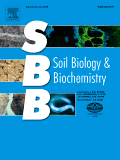
SOIL BIOLOGY & BIOCHEMISTRY
Connecting Research and Practical Solutions in Soil HealthSOIL BIOLOGY & BIOCHEMISTRY, published by Pergamon-Elsevier Science Ltd, is a premier academic journal that plays a pivotal role in advancing the fields of microbiology and soil science. Established in 1969, this esteemed journal has gained recognition for its rigorous publication standards and impactful research contributions, evidenced by its prestigious Q1 rankings in both Microbiology and Soil Science categories for 2023. With an impressive Scopus rank of #3 among 159 in Agricultural and Biological Sciences and #14 among 182 in Immunology and Microbiology, it boasts a notable 98th percentile in its field. The journal offers researchers, professionals, and students a vital platform for sharing innovative studies and insights about soil ecosystems and their biochemical processes, fostering greater understanding and collaboration within the scientific community. While Open Access options are currently not available, the journal remains a cornerstone for those seeking to deepen their knowledge and contribute significantly to soil biology and biochemistry.
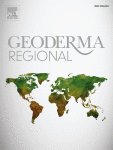
Geoderma Regional
Pioneering insights into soil dynamics and management.Geoderma Regional is a premier scholarly journal dedicated to advancing the field of Soil Science. Published by Elsevier in the Netherlands, this journal serves as a vital platform for disseminating high-quality, peer-reviewed research that spans the complexities of soil management, behavior, and the implications of soil processes on environmental sustainability. Since its inception in 2014, Geoderma Regional has achieved an impressive position within the academic community, holding a Q1 ranking in the field of Soil Science, placing it among the top 20% of journals in its category according to SCOPUS rankings. This journal is particularly distinguished for its significant contributions to the nexus between agriculture and biological sciences, reflected in its rank of #33 out of 159 in this field with a commendable 79th percentile. Researchers, professionals, and students alike will appreciate the journal's commitment to open discourse and innovative research agendas as it aspires to enhance our understanding of soil dynamics, addressing critical issues facing our planet.
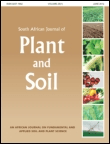
South African Journal of Plant and Soil
Fostering knowledge for sustainable environmental solutions.South African Journal of Plant and Soil is an esteemed academic publication dedicated to advancing the fields of Ecology, Plant Science, and Soil Science. Published by TAYLOR & FRANCIS LTD in the United Kingdom, this journal has been a vital resource since its inception in 1984, providing a platform for innovative research and scholarly articles that address critical issues in plant and soil management. With a current impact factor placing it in the Q3 category according to the 2023 rankings, it occupies an influential position within the academic community, especially amongst researchers focused on agricultural and environmental sciences. Although not an open-access journal, it remains accessible to a broad audience through libraries and institutions that recognize its value in facilitating ecologically and environmentally focused discussions. The journal's ongoing commitment to publishing high-quality research ensures that it plays a pivotal role in nurturing knowledge and fostering advancements in sustainable practices across southern Africa and beyond.

EGYPTIAN JOURNAL OF SOIL SCIENCE
Unveiling Insights for Agricultural ExcellenceEGYPTIAN JOURNAL OF SOIL SCIENCE is a renowned publication dedicated to advancing the field of soil science, particularly within the context of Egypt and the broader regions of the Middle East and North Africa. Published by the NATIONAL INFORMATION DOCUMENTATION CENTER, ACADEMIC SCIENTIFIC RESEARCH & TECHNOLOGY, this journal aims to disseminate high-quality research and innovative practices related to soil management, conservation, and sustainable agricultural practices. With an emphasis on empirical studies, reviews, and methodologies relevant to soil health and productivity, this journal serves as an essential resource for researchers, professionals, and students alike. Although specific access options are not highlighted, the journal’s commitment to promoting scholarly discourse ensures that important findings within soil science are made available to wider audiences, contributing significantly to environmental science, agronomy, and ecological preservation.

Terra Latinoamericana
Innovating Soil Science: A Platform for ChangeTerra Latinoamericana is a prominent academic journal published by the Mexican Society of Soil Science, focusing on the essential disciplines of soil science, biochemistry, and ecology. With a dedicated commitment to open access since 2014, this journal provides a platform for researchers and professionals to disseminate and access cutting-edge research aimed at understanding soil interactions, environmental pollution, and ecosystems within Latin America. The journal holds a Q4 ranking in multiple categories, including Ecology and Soil Science, reflecting its growing presence in the academic landscape and its role in fostering scholarly communication within these fields. Though currently positioned in the lower quartiles, Terra Latinoamericana presents a valuable opportunity for emerging scholars and experienced researchers alike to contribute impactful findings and engage with key issues affecting soil health and ecological sustainability in diverse environments. By promoting innovative research and collaborative dialogue, this journal continues to shape the future of soil science and related disciplines, making it an indispensable resource for the scientific community.
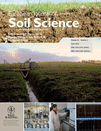
EUROPEAN JOURNAL OF SOIL SCIENCE
Connecting Science to Soil Sustainability ChallengesEUROPEAN JOURNAL OF SOIL SCIENCE, published by Wiley, stands as a leading platform in the field of soil science, recognized for its contributions to the understanding of soil ecology, management, and sustainability. With an impressive impact factor and a distinguished Q1 ranking in Soil Science, this journal has recently ranked 23rd out of 159 in its category on Scopus, placing it in the 85th percentile among its peers. Covering a wide array of topics as it converges into the future, from 1994 to 2024, the journal aims to disseminate groundbreaking research and innovative methodologies that address the pressing challenges of soil degradation and environmental sustainability in Europe and beyond. Although it is not an open access journal, the EUROPEAN JOURNAL OF SOIL SCIENCE remains a vital resource for researchers, professionals, and students seeking to deepen their understanding and explore the latest advancements in soil science.

CANADIAN JOURNAL OF SOIL SCIENCE
Empowering Soil Science for Agricultural InnovationThe Canadian Journal of Soil Science (ISSN: 0008-4271, E-ISSN: 1918-1841) is a premier publication in the field of soil science, proudly published by Canadian Science Publishing. Established in 1974, this esteemed journal aims to promote high-quality research and insights into the dynamic interactions within soil ecosystems, addressing pressing issues such as soil health, management, and sustainability. With an impressive 2023 category quartile ranking of Q2 in Soil Science and a Scopus ranking placing it in the 52nd percentile, this journal stands out as a key resource for researchers, professionals, and students alike. Although currently not open access, the journal provides valuable content that contributes to advancing the understanding of soil science, an essential discipline for agricultural innovation and environmental stewardship. As we approach its converged years through 2024, the Canadian Journal of Soil Science is poised to continue its pivotal role in disseminating impactful research and fostering a community dedicated to soil science excellence.
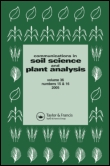
COMMUNICATIONS IN SOIL SCIENCE AND PLANT ANALYSIS
Bridging Theory and Practice in AgronomyCOMMUNICATIONS IN SOIL SCIENCE AND PLANT ANALYSIS, published by Taylor & Francis Inc, is a prestigious journal dedicated to advancing research in the fields of agronomy, crop science, and soil science. Established in 1970, the journal has maintained a significant presence over the years, with a commitment to publishing high-quality, peer-reviewed articles that contribute to the understanding of soil and plant interactions. With an impressive Q2 ranking in both Agronomy and Soil Science, it positions itself as a vital resource for researchers, professionals, and students alike, keen on exploring innovative solutions to contemporary agricultural challenges. Although it currently does not provide open access, the journal ensures wide dissemination through its established subscription services. The journal's focus on empirical research, methodologies, and technological advancements in soil management and plant nutrition makes it an essential platform for disseminating knowledge and fostering discussions within the scientific community. Located in the heart of Philadelphia, USA, it remains a significant contributor to the global dialogue on sustainable agriculture and environmental stewardship.